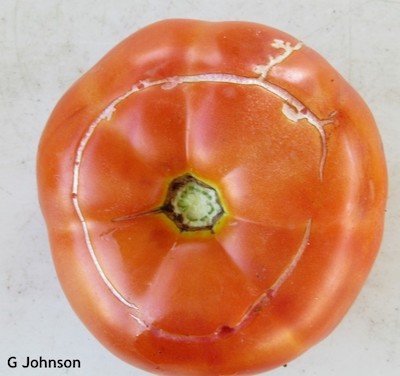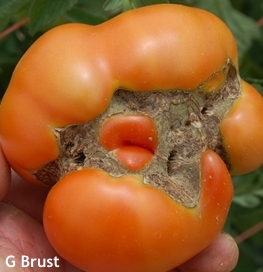Five Tomato Problems You May Have Caused
By Ray Novitske, Fairfax Master Gardener
 We want to grow tomatoes, but sometimes the problems we must overcome seem overwhelming. With early blight, late blight, septoria leaf spot, anthracnose, and other fungal diseases threatening to compromise our tomato patches, we wonder whether growing our own is worth the effort. Mother Nature causes some of the trouble. Other problems, we gardeners cause. Here are five of the latter, and what to do about them:
We want to grow tomatoes, but sometimes the problems we must overcome seem overwhelming. With early blight, late blight, septoria leaf spot, anthracnose, and other fungal diseases threatening to compromise our tomato patches, we wonder whether growing our own is worth the effort. Mother Nature causes some of the trouble. Other problems, we gardeners cause. Here are five of the latter, and what to do about them:
Bloom drop, no tomatoes
Tomato blossoms self-pollinate but this process is sensitive to temperature and moisture. The blossoms last a maximum of two days before falling off and, without optimal conditions, they may not get pollinated. The temperature must be between 70 and 85 degrees (21 – 29 C). If daytime temperatures consistently hover above 90 with nights above 75, tomatoes abandon their fruit production and instead concentrate their energy on survival. Temperatures below 60 also result in few fruits because of poor pollination.
 Blossoms will drop off if the plants are water-stressed, too. If the weather is hot and dry or if the plants are not adequately watered, they could dry out too much between waterings. Dry conditions also create other problems, detailed below.
Blossoms will drop off if the plants are water-stressed, too. If the weather is hot and dry or if the plants are not adequately watered, they could dry out too much between waterings. Dry conditions also create other problems, detailed below.
When they grew tomatoes, my grandparents always cut off all the side shoots to concentrate the production into one stalk. This created larger but fewer fruits, I was told. It also opened the plant and soil to more sun. Allowing the leaves from side shoots to remain, however, helps shade and cool the plant and its blooms.
Some varieties can tolerate higher temperatures. Cherry tomatoes, for example, set fruit over a wider temperature range than the larger fruit tomatoes. But heirloom tomatoes tend to be pickier about temperatures than more recent hybrids are. Choosing a better variety for your growing conditions may help. Regardless, when proper temperatures return, the plants will begin producing again.
Blossom end rot
When a sunken, dark-brown decay develops on the blossom ends of your tomatoes, you have blossom end rot. It usually shows up as the green tomatoes are growing or have begun to ripen and can cover up to half of each fruit. It is caused by insufficient calcium in the tissue of the growing tomato.

Blossom end rot
Because calcium is only moved into the plant with an ample moisture supply, preventing dry conditions and inconsistent soil moisture is the best way to avoid this problem. Water deeply and thoroughly, if needed, and mulch the soil to prevent it from drying out between waterings. Maintain tomato leaf cover to keep the soil shaded. Finally, know that the rot does not spread from plant to plant or from fruit to fruit and will disappear when conditions improve.
Cracking

Concentric circle cracking
Cracking is essentially caused by inconsistent watering. Dry periods followed by a sudden supply of water such as a large rainstorm exacerbate the problem. Letting your tomato plants dry out between waterings will also cause cracking.

Radial cracking
To prevent cracking, be sure to water regularly during dry spells to maintain an even soil moisture and avoid a sudden influx of water. Use mulch to help shield the soil from drying out. Select varieties that are resistant to cracking.
Catfacing

Catfacing
Cold temperatures during flowering can increase its incidence, as can extreme variations in day and night temperatures (hot days and cold nights). Also, excessive pruning and excessive nitrogen (from over fertilizing) can increase the likelihood. Certain varieties, again those with larger fruit size, are more susceptible.
Zippering

Zippering
Choosing tomato varieties suited to your growing conditions can go a long way to preventing these five issues. Some problems caused by Mother Nature are superficial and do not affect the taste or edibility of the fruits of your labor. But some can be caused by the growing environment you provide. Better cultural practices that begin with you can solve these problems.
References
• Blossom End Rot of Tomato and Pepper, Virginia Cooperative Extension
• Zippering (fruit disorder) on Tomatoes, Cornell University
• More on Fruit Cracking in Tomato, Gordon Johnson, University of Delaware
• Cracking – Vegetables, University of Maryland
• Blossom-end Rot of Tomato Tip Sheet, Michigan State University Extension
• Blossom End Rot of Tomato, Cornell University
• Tomato, Clemson University Home & Garden Information Center
• Blossom Drop and Reduced Fruit Set in Tomato, Monica Ozores-Hampton and Fnu Kiran, University
of Florida
• Horticulture and Home Pest News, Iowa State University Extension and Outreach